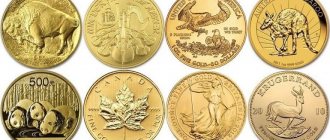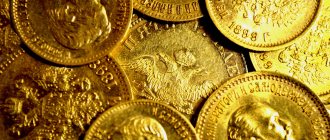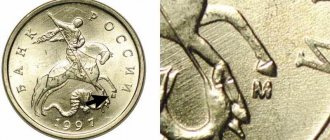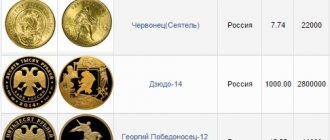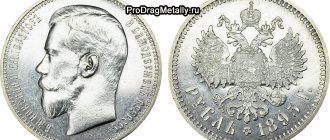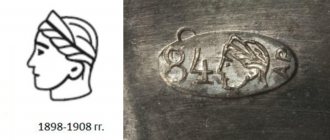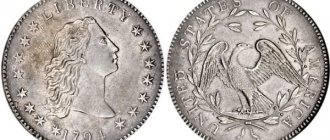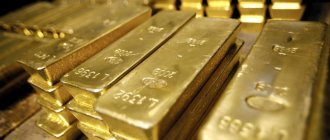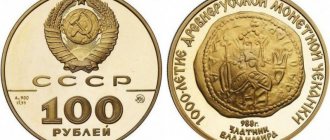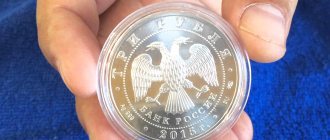Other articles Added by: drdd Edited by: Admin
Antique coin scales (Hermitage exhibition)
The basis of any examination of a coin is its weighing. A deviation from the norm may mean that the coin is counterfeit. In addition, the low weight of gold coins with a normal diameter and thickness indicates a low standard. It should be taken into account that until the middle of the 19th century there were no clear weight standards for small coins, so when checking for authenticity, the error must be taken into account. Copper coins of the 18th century have a deviation of up to 20%; for silver and gold coins it is much less. The information presented in the tables will help in self-identification, especially in cases where due to severe wear it is impossible to read the denomination. For example, copper coins from 1757 to 1796 with a denomination of up to 5 kopecks have an absolutely identical design, the only difference is in the writing of the denomination, which cannot always be distinguished.
National coins
Copper coins:
| Denomination | Minting time | Weight in grams |
| Half a half | 1700 | 1,60 |
| Polushka, 1/4 kopeck | 1700-1701 | 3,20 |
| 1701-1704 | 2,65 | |
| 1704-1712 | 2.13 and 2.05 | |
| 1713-1718 | 2,05 | |
| 1718-1722 | 1,02 | |
| 1727 | 1,02 | |
| 1730-1754 | 4,10 | |
| 1757-1796 | 2,56 | |
| 1796 | 1,28 | |
| 1797-1810, 1839-1846 | 2,56 | |
| 1849-1867 | 1,28 | |
| 1867-1916 | 0,82 | |
| Denga, Denga, Money, 1/2 kopeck | 1700-1701 | 6,40 |
| 1701-1704 | 5,30 | |
| 1704-1712 | 4.27 and 4.10 | |
| 1713-1718 | 4,10 | |
| 1718 | 2,05 | |
| 1730-1754 | 8,19 | |
| 1757-1760 | 5,12 | |
| 1762 | 2,56 | |
| 1763-1796 | 5,12 | |
| 1796 | 2,56 | |
| 1797-1810 | 5,12 | |
| 1810-1828 | 3,41 | |
| 1839-1848 | 5,12 | |
| 1849-1867 | 2,56 | |
| 1867-1916 | 1,64 | |
| Kopek | 1704-1712 | 8.35 and 8.19 |
| 1713-1718 | 8,19 | |
| 1718 and 1721 | 4,10 | |
| 1724 and 1726 | 8,19 | |
| 1727-1729 | 4,10 | |
| 1730, 1735, 1743 and 1755-1757 | 20,48 | |
| 1757-1761 | 10,24 | |
| 1762 | 5,12 | |
| 1763-1796 | 10,24 | |
| 1796 | 5,12 | |
| 1797-1810 | 10,24 | |
| 1810-1830 | 6,83 | |
| 1830-1839 | 4,55 | |
| 1839-1847 | 10,24 | |
| 1849-1867 | 5,12 | |
| 1867-1917 | 3,28 | |
| 1916 | 1,64 | |
| Penny, 2 kopecks | 1724 and 1727 | 8,19 |
| 1740, 1757-1762 | 20,48 | |
| 1760 and 1762 | 10,24 | |
| 1763-1796 | 20,48 | |
| 1796 | 10,24 | |
| 1797-1810 | 20,48 | |
| 1810-1830 | 13,65 | |
| 1830-1839 | 9,10 | |
| 1839-1848 | 20,48 | |
| 1849-1867 | 10,24 | |
| 1867-1916 | 6,55 | |
| 1916 | 3,28 | |
| 3 kopecks | 1827 | 13,65 |
| 1839-1848 | 30,71 | |
| 1849-1867 | 15,36 | |
| 1867-1916 | 9,83 | |
| 1916 | 4,91 | |
| 4 kopecks | 1762 and 1796 | 20,48 |
| 5 kopecks | 1727-1730 and 1740 | 20,48 |
| 1757-1796 | 51,19 | |
| 1796 | 25,59 | |
| 1802-1810 | 51,19 | |
| 1830-1839 | 22,75 | |
| 1849-1867 | 25,59 | |
| 1867-1917 | 16,38 | |
| 1916 | 8,19 | |
| Hryvennik, Hryvnia, 10 kopecks | 1726 | 40,95 |
| 1762 and 1796 | 51,19 | |
| 1830-1839 | 45,50 | |
| Sestroretsk ruble | 1770-1771 | 1023,78 |
Square boards:
| Denomination | Minting time | Weight in grams |
| Kopek | 1726 | 16,38 |
| Five kopecks | 1726 | 81,90 |
| Hryvnia | 1725-1727 | 163,80 |
| Half a half | 1725-1726 | 409,51 |
| Poltina | 1726 | 819,03 |
| Ruble | 1725-1726 | 1638,05 |
"Siberian" coins:
| Denomination | Minting time | Weight in grams |
| 10 kopecks | 1764-1781 | 65,52 |
| 5 kopecks | 1764-1780 | 32,76 |
| 2 kopecks | 1764-1780 | 13,10 |
| Kopek | 1764-1779 | 6,55 |
| Money | 1764-1779 | 3,28 |
| Polushka | 1766-1779 | 1,64 |
Silver coins:
| Denomination | Minting time | Weight in grams |
| Kopek | 1713-1714 | 0,60 |
| 1718 | 0,57 | |
| 1729-1730 | 0,30 | |
| Grosh | 1727 | 0.55 and 1.27 |
| Altyn, Altynnik, 3 kopecks | 1704 | 0,80 |
| 1710-1712 | 0,84 | |
| 1713-1714 and 1718 | 1,70 | |
| 1727 | 0,80 | |
| Ten money, 5 kopecks | 1701-1704 | 1,40 |
| 1713-1714 | 2,83 | |
| 1755-1761 | 1,21 | |
| 1762 | 1,17 | |
| 1763 | 1,20 | |
| 1797 | 1,46 | |
| 1798-1801 | 1,04 | |
| 1810-1812 | 1,20 | |
| 1813-1860 | 1,04 | |
| 1860-1866 | 1,02 | |
| 1867-1915 | 0.90 | |
| Hryvennik, Hryvnia, 10 kopecks | 1701-1706 | 2,84 |
| 1707-1708 | 2,84 | |
| 1710 and 1713 | 2,84 | |
| 1718-1723 | 2,84 | |
| 1726-1727 | 2,66 | |
| 1731-1739 | 2,59 | |
| 1741-1745 | 2,59 | |
| 1746-1757 | 2,42 | |
| 1764-1796 | 2,37 | |
| 1797 | 2,93 | |
| 1798-1810 | 2,07 | |
| 1810-1812 | 2,40 | |
| 1813-1860 | 2,07 | |
| 1860-1866 | 2,04 | |
| 1867-1917 | 1,80 | |
| 15 kopecks | 1760 | 3,60 |
| 1762 | 3,52 | |
| 1763 | 3,60 | |
| 1764-1794 | 3,56 | |
| 1832-1841 | 3,11 | |
| 1860-1866 | 3,06 | |
| 1867-1917 | 2,70 | |
| 20 kopecks | 1760 | 4,80 |
| 1762 | 4,72 | |
| 1763 | 4,80 | |
| 1764-1793 | 4,77 | |
| 1810-1811 | 4,80 | |
| 1813-1860 | 4,15 | |
| 1860-1866 | 4,08 | |
| 1867-1917 | 3,60 | |
| Half-fifty, Half-and-half, 25 kopecks | 1699-1706 | 7,00 |
| 1707 | 7,00 | |
| 1710 | 7,00 | |
| 1713 | 7,00 | |
| 1726 | 6,68 | |
| 1730 | 7,11 | |
| 1739-1794 | 6,46 | |
| 1755-1758 | 6,04 | |
| 1764-1796 | 5,97 | |
| 1797 | 7,31 | |
| 1798-1885 | 5,18 | |
| 1860 | 6,00 | |
| 1886-1901 | 5,00 | |
| Poltina, Poltinnik, 50 kopecks | 1699-1706 | 14,00 |
| 1707 | 14,00 | |
| 1710 | 14,00 | |
| 1712 | 14,25 | |
| 1718-1729 | 14,22 | |
| 1731-1761 | 12,93 | |
| 1762-1796 | 12,00 | |
| 1797 | 14,63 | |
| 1798-1885 | 10,37 | |
| 1860 | 12,00 | |
| 1886-1914 | 10,00 | |
| Ruble | 1704-1705 | 28,00 |
| 1707 | 28,00 | |
| 1710 | 27,50 | |
| 1712-1714 | 28,50 | |
| 1718-1729 | 28,44 | |
| 1730-1761 | 25,85 | |
| 1762-1796 | 24,00 | |
| 1796-1797 | 29,25 | |
| 1798-1885 | 20,73 | |
| 1860 | 24,00 | |
| 1886-1915 | 20,00 | |
| 1 1/2 rubles | 1833-1841 | 31,10 |
| Efimok | 1798 | 37,10 |
Golden coins:
| Denomination | Minting time | Weight in grams |
| Poltina | 1756 | 0,80 |
| 1777-1778 | 0,65 | |
| Ruble | 1756-1758 | 1,60 |
| 1779 | 1,31 | |
| 2 rubles | 1718-1728 | 4,10 |
| 1756, 1758 | 3,24 | |
| 1766, 1785 | 2,62 | |
| 3 rubles | 1834-1841 | 3,93 |
| 1869-1885 | 3,93 | |
| Chervonets | 1701-1711 | 3,47 |
| 1712-1716 | 3,47 | |
| 1729-1748 | 3,47 | |
| 1749-1753 | 3,47 | |
| 1796-1797 | 3,49 | |
| Double chervonets | 1701-1702 | 6,94 |
| 1714 | 6,94 | |
| 1749-1751 | 6,94 | |
| 5 russ | 1895 | 4,30 |
| 5 rubles | 1755-1763 | 8,23 |
| 1764-1796 | 6,54 | |
| 1798-1805 | 6,08 | |
| 1817-1885 | 6,54 | |
| 1886-1896 | 6,54 | |
| 1897-1911 | 4,30 | |
| 7 rubles 50 kopecks | 1897 | 6,45 |
| 10 rubles | 1755-1763 | 16,54 |
| 1764-1796 | 13,09 | |
| 1802-1805 | 12,17 | |
| 1886-1897 | 12,90 | |
| 1896-1911 | 8,60 | |
| 10 russ | 1895 | 8,60 |
| 15 russ | 1895 | 12,90 |
| 15 rubles | 1897 | 12,90 |
| 20 rubles | 1755 | 33,14 |
| 25 rubles | 1876 | 32,72 |
| 1896, 1908 | 32,26 | |
| 37 rubles 50 kopecks - 100 francs | 1902 | 32,26 |
Platinum coins:
| Denomination | Minting time | Weight in grams |
| 3 rubles | 1828-1845 | 10,35 |
| 6 rubles | 1829-1845 | 20,71 |
| 12 rubles | 1830-1845 | 41,71 |
How much do 10 kopecks weigh?
If the question had indicated not weight, but diameter, the answer would have been unchanged since the time of Paul the First. But the weight directly depended on the silver, the sample of which underwent changes. So Anna Ioannovna’s ten-kopeck piece was made from 802-grade silver, and it weighed 2.59 grams. Under Ivan Antonovich and Elizabeth, the 750th sample of metal was already used, and since 1746 the weight has been reduced to 2.42 grams. Peter the Third transfers the ten-kopeck denomination to the group of copper coins, which leads to a dramatic change in weight - 51.19 grams. Catherine the Second returns the silver ten-kopeck piece, but with her it already weighs 2.37 grams. At the end of her reign we will again see 10 kopecks made of copper (51.19 g). Pavel the First mints silver coins from 868-carat metal. The weight of the dime first increases to 2.93 grams, but then sharply drops to 2.07 grams. He remains the same under Alexander and Nicholas. However, during the last decade, heavy (45.45 g) ten-kopeck coins were also minted from copper. Alexander II consistently reduces the silver standard from 868 to 500 (billion). The weight of our denomination is also reduced to 1.8 grams. It remained in this weight until the 30s of the 20th century, when cupronickel replaced silver.
Regional releases
Poland (copper):
| Denomination | Minting time | Weight in grams |
| 3 groschen | 1817-1841 | 8,57 |
| 1 penny | 1816-1841 | 2,86 |
Poland (silver):
| Denomination | Minting time | Weight in grams |
| 10 zloty | 1820-1827 | 31,08 |
| 5 zlotys | 1816-1834 | 15,54 |
| 2 zlotys | 1816-1834 | 9,09 |
| 1 zloty | 1818-1834 | 4,54 |
| 10 groschen | 1816-1840 | 2,91 |
| 5 groschen | 1816-1841 | 1,54 |
Poland (gold):
| Denomination | Minting time | Weight in grams |
| 50 zlotys | 1817-1823 | 9,81 |
| 1827 | 9,81 | |
| 1829 | 9,81 | |
| 25 zlotys | 1817-1819 | 4,91 |
| 1822-1825 | 4,91 | |
| 1828-1829 | 4,91 | |
| 1832-1833 | 4,91 | |
| Ducat | 1831 | 3,49 |
Russian-Polish denomination designation (silver):
| Denomination | Minting time | Weight in grams |
| 1 1/2 rubles - 10 zlotys | 1833-1841 | 31,10 |
| 3/4 ruble - 5 zloty | 1833-1841 | 15,55 |
| 30 kopecks - 2 zlotys | 1834-1841 | 6,22 |
| 25 kopecks - 50 groschen | 1842-1850 | 5,18 |
| 20 kopecks - 40 groschen | 1842-1850 | 4,15 |
| 15 kopecks - 1 zloty | 1832-1841 | 3,11 |
| 10 kopecks - 20 groschen | 1842 | 2,07 |
| 5 kopecks - 10 groschen | 1842 | 1,04 |
Russian-Polish denomination (gold):
| Denomination | Minting time | Weight in grams |
| 3 rubles - 20 zlotys | 1834-1841 | 3,93 |
Finland (copper):
| Denomination | Minting time | Weight in grams |
| 20 pennies | 1863 | 25,60 |
| 10 pennies | 1863-1917 | 12,80 |
| 5 pennies | 1863-1917 | 6,40 |
| 2 pennies | 1866 | 2,59 |
| 1 penny | 1863-1917 | 1,28 |
Finland (silver):
| Denomination | Minting time | Weight in grams |
| 2 stamps | 1865-1908 | 10,37 |
| 1 stamp | 1864-1915 | 5,18 |
| 50 pennies | 1865-1917 | 2,55 |
| 25 pennies | 1865-1917 | 1,27 |
| 20 pennies | 1866 | 1,02 |
Finland (gold):
| Denomination | Minting time | Weight in grams |
| 20 marks | 1878-1880 | 6,45 |
| 1891 | 6,45 | |
| 1903-1904 | 6,45 | |
| 1910-1913 | 6,45 | |
| 10 marks | 1878-1879 | 3,23 |
| 1881-1882 | 3,23 | |
| 1904-1905 | 3,23 | |
| 1913 | 3,23 |
Prussia:
| Denomination | Minting time | Weight in grams |
| 1/3 thaler | 1761 | 7,79 |
| 18 groschen | 1759-1761 | 5,85 |
| 1/6 thaler | 1761 | 4,31 |
| 6 groschen | 1759-1762 | 2.83 and 2.79 |
| 3 groschen | 1759-1761 | 1.56 and 1.54 |
| 2 pennies | 1759-1761 | 1.46 and 1.44 |
| 1 penny | 1759-1761 | 0.84 and 0.82 |
| Solid | — | — |
Georgia (copper):
| Denomination | Minting time | Weight in grams |
| Bisti | 1804-1833 | 6,31 |
| 1828 | 6,66 | |
| Half-bisti | 1804-1831 | 3,15 |
| 1828 | 3,33 | |
| Bullets | 1804-1833 | 1,58 |
Georgia (silver):
| Denomination | Minting time | Weight in grams |
| Double Abaz | 1804-1810 | 15,55 |
| Abaz | 1804-1810 | 7,77 |
| Semi-base | 1804-1806 | 3,89 |
Moldavia and Wallachia:
| Denomination | Minting time | Weight in grams |
| 5 kopecks | 1771 | 37,92 |
| 2 pair - 3 kopecks | 1772-1774 | 22,75 |
| 3 money | 1771 | 11,37 |
| Pair - 3 money | 1771-1773 | — |
Baltics:
| Denomination | Minting time | Weight in grams |
| 96 kopecks | 1756-1757 | 26,38 |
| 48 kopecks | 1756-1757 | 13,19 |
| 24 kopecks | 1756-1757 | 6,59 |
| 4 kopecks | 1756-1757 | 1,10 |
| 2 kopecks | 1756-1757 | 1,05 |
Tauride coins:
| Denomination | Minting time | Weight in grams |
| 20 kopecks | 1787 | 8,73 |
| 10 kopecks | 1787 | 4,37 |
| 5 kopecks | 1787 | 2,18 |
| 2 kopecks | 1787 | 0,87 |
Polish-Lithuanian Commonwealth:
| Denomination | Minting time | Weight in grams |
| Poltinfa (six hundred) | 1707 | 3,20 |
| Tinf | 1707-1709 | 6,40 |
Principality of Holstein-Gottorp:
| Denomination | Minting time | Weight in grams |
| Albertusthaler | 1753 | 28,07 |
Principality of Jever:
| Denomination | Minting time | Weight in grams |
| Thaler | 1798 | 22,27 |
| Poltalera | 1798 | 11,14 |
Article last modified: 02/07/2018
Other articles
Weight of 1 kopeck in Russia
But the penny has been stable for two decades. And this saves knowledgeable people a lot of time! Knowing that a modern penny is one and a half grams of metal, we will not count a mountain of penny coins. We weigh them and take two-thirds of the displayed value, thereby obtaining the quantity and total amount. Under the USSR, a penny weighed exactly one gram. Since 1926, the weight of one, two, three and five kopecks corresponded to their face value, which made it possible not only to accept coins by weight, but also to use small coins as improvised weights.
With the help of weighing, numismatists easily and simply separate the expensive mix-ups of three kopecks on a two-kopeck piece from the colored coins. The weight of the original in nickel silver is 3.4 grams, and the coated troyak will show 3 grams when weighed. with acceptable deviations. We hope that our little research has proven to you how important weight characteristics are in numismatics. Scales are a necessary item in the arsenal of any serious numismatist.
Modern units of measurement for precious stones and metals
Weight of pure gold in grams
The carat, already described above, which is of Arabic origin, is now widely used to measure the weight of precious stones. The weight of one carat has changed at different times and in different countries, but is now equivalent to 0.2 grams. For metals, the English system of measures is used, which includes the English pound (453.59237 g), English ounce (28.349523125 g), grain (1/7000 of a pound), troy ounce (31.1034768 g), and other, lesser-known measures. The troy ounce (480 grains) has become an international measure of the weight of precious metals. The name comes from the city of Troyes in northern France, which in the Middle Ages was one of the important European trading hubs; the troy ounce is based on the French livre. Almost all investment and collection coins of Russia and other countries have a pure metal weight of a certain fraction of a troy ounce, or several ounces. Taking into account the fineness, the total weight of the coins is higher. For example, silver 3-ruble coins issued since 1992 include 1 ounce of pure silver, and the gold investment coin “St. George the Victorious” contains ¼ ounce of gold. The exchange rate of precious metals against foreign currencies is also expressed in troy ounces. Soviet gold chervonets, based on the Old Russian system of measures, differ slightly in weight from ¼ ounce, but are close to it. Photos provided by site users: Andrey_P, Moneta100, Admin.
Article last modified: 01/11/2018
Other articles
Comments:
Hello!
My great-grandmother said that her father: “Measured gold in buckets.” This phrase is passed down from generation to generation. I have been looking for information for a long, long time, WHAT buckets are we talking about? (how rich was our family before the revolution?) This apparently happened in the 19th century - my great-grandmother was born at the end of the 19th century. Help me please. THANK YOU. 05/16/2012 at 17:24:10
Most likely, your great-grandmother wanted to show with this phrase that her father was very rich. It’s just a saying, like: “Money doesn’t matter to chickens.” In fact, gold was not measured with any buckets.
Author: Admin 05/17/2012 at 02:30:31
To add a comment, register
Price
The price of silver rubles from Tsarist Russia varies depending on the degree of preservation, the features of the coin and the circulation. An important feature that increases the value of a monetary unit is errors in coinage and history associated with its appearance. For example, before the coronation of Constantine I, a test batch of silver rubles was minted, but the future king never ascended the throne (Nicholas was crowned instead). The circulation did not enter circulation, but the price of such coins reached $100,000.
The most expensive silver coins of Tsarist Russia 1701-1911. with price:
- 1 ruble of 1705 Peter I with an error in the year of minting – $23,000;
- 1 ruble 1730 “Anna with a chain” – $700,000;
- 1 ruble 1806 experimental with a portrait of Alexander I – $285,000;
- 1 ruble 1825 experimental with a portrait of Konstantin Pavlovich - $100,000;
- 1 ruble of 1861 (from 70,000 coins only 10 pieces remain) – $21,000.
Many silver coins of Tsarist Russia Nicholas II were counterfeited in the post-revolutionary era, so before you buy Nicholas rubles, it is important to check whether they are original or fake. In the first years of the existence of the USSR, the Soviet government did not have the opportunity to create its own stamp; the royal stamp and production were used for minting.
